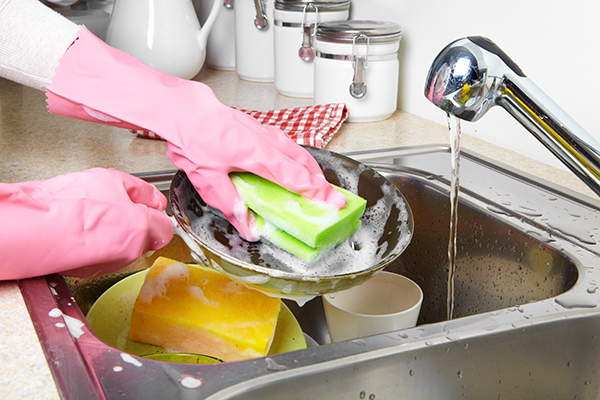Safely Shopping at Farmers’ Markets: A Food Safety Guide for Foodservice Operators and Chefs
Farmers’ markets are an appealing source of fresh, local, and seasonal ingredients for individuals and families across the United States. They also provide an excellent source of products for foodservice operators and chefs. Local farmers’ markets offer the opportunity to build relationships with local growers, reduce food miles, and bring fresh flavors to the plate. However, shopping at farmers’ markets for a commercial kitchen involves more than selecting the ripest tomato or the best watermelon; it requires a careful eye toward food safety.
One of the benefits of sourcing from farmers’ markets is the ability to speak directly with the people growing your food. Use this opportunity to ask about their food safety practices, including how the produce is harvested, washed, and stored; what the source of the water used for irrigation and washing is, and how livestock and produce areas are separated to avoid cross-contamination.
Further, inquire if the farmer participates in any food safety training or certification programs, such as the USDA’s Good Agricultural Practices (GAP) program. While GAP certification is not mandatory, it verifies that farms are following science-based guidelines to minimize the risk of microbial contamination during growing, harvesting, packing, and transporting food. Even if a grower is not certified, many adopt the practices, so it’s worth having an informed conversation.
…Many consumers think local means safer. And while you may know the grower and perhaps even the plot of land that a product comes from, it doesn’t necessarily mean that it is safer.
When selecting produce, keep an eye on the basic quality of the product, just as you would inspect the product if it were delivered from your broadline distributor. Is the skin or rind intact, with no visible mold, bruising, or decay? Observe the packaging and display areas. Are they relatively clean? Ensure that no produce is placed directly on the ground. Determine if there is a clear separation between raw animal products (e.g., eggs or meat) and produce to avoid cross-contamination. If dairy, eggs, or meats are sold, verify that they are held at safe temperatures with proper refrigeration or coolers.
After purchase, the safety of the product becomes your responsibility. Transport perishable items in coolers with ice packs or insulated containers. Always label and date products as you would with any other product in your business. Store items in separate containers to prevent cross-contamination between produce and proteins.
Although farmers’ markets may not offer the same level of documentation as large-scale distributors, traceability is still essential. Keep records of what was purchased, from whom, and on what date. Save receipts or take photos of vendor signs along with your purchases.
If your state or local regulations mandate that you use only approved or licensed sources, check with your local or state regulatory agency to ensure your farmers’ market purchases are compliant. Some local regulations require documentation for farm-sourced products used in commercial settings.
Last, but certainly not least, ensure your kitchen staff are trained on safe handling practices for locally sourced foods, which may not arrive in the same packaging or condition as commercial deliveries. Reinforce the importance of checking temperatures, washing all produce, and documenting sourcing. Develop a standard operating procedure for handling farmers’ market purchases or update your existing SOPs.
If you develop ongoing partnerships with local growers, consider encouraging them to pursue GAP certification or share their current food safety plans with you. Collaborating on food safety builds trust and contributes to a stronger local food system.
Many consumers think local means that the product is safer. And while you may know the grower and perhaps even the plot of land that a product comes from, it doesn’t necessarily mean that it is safer. By building relationships and applying the same due diligence to your local purchases as you do your other orders, you can bring the best of the farmers’ market to your menu with confidence and care. Risk Nothing.
READ MORE POSTS
Welcome to National Food Safety Education Month!
In September of each year, we not only have the opportunity to celebrate Labor Day, but we also welcome National Food Safety Education Month! It is this time of the year when it is important to remember that Foodborne illnesses are still a major concern in the United States, although I am guessing many Americans don’t think about the safety of the food they eat as they go throughout their daily lives. The statistics show one in every six Americans will suffer from a foodborne illness each year, for a total of about 48 million cases each year.
Protecting Fresh Produce Post-Harvest, Integral to Safe Food
During the height of the summer, at least in the Midwest, farmers markets are in full swing and fresh produce is plentiful. Every backyard gardener is reaping the benefits of their work, with bountiful harvests of tomatoes and cucumbers. Everyone seems to have a neighbor who is trying to pawn off his or her over-production of cucumbers or summer squash during this time of year. When picking up that produce at the farmer’s market or from your neighbor down the street, have you ever given any thought to the microbial safety of it? Honestly, even in my position, it certainly is NOT the first thing that comes to my mind. But, earlier this month, I came across a news story out of Wisconsin discussing a Salmonella outbreak associated with shelled peas sold at a local farmers market. Who would have thought shelled peas would be impacted? The story noted, and it served as a great reminder, that most outbreaks associated with Salmonella in produce are due to mistakes made in handling or transportation of produce after harvesting.
Properly Cleaning and Sanitizing: The Right Chemical Mix to Maintain Ultimate Effectiveness
A few weeks ago, my family and I had the pleasure of setting sail on a cruise vacation. It is truly one of the only ways that I find that I am able to unplug from work and relax for a small spell. However, as I walked around the ship in our post-COVID world, I couldn’t help but admire all the extra cleaning steps the staff were undertaking to keep us all as safe as possible while in the middle of the ocean with 3,000 other vacationers. All of this cleaning and sanitizing had me thinking about how we each clean and sanitize our own operations and which chemicals we chose to use.
Proper Cooking Temperature: A Basic Food Safety Measure
Each summer, we see an increase in the incidence of foodborne illnesses. Perhaps this is because of the warmer temperatures making temperature control for Time/Temperature Control for Safety (TCS) food more difficult or perhaps it is the increased amount of people who are barbequing this time of year – it is National Picnic Month, after all!










